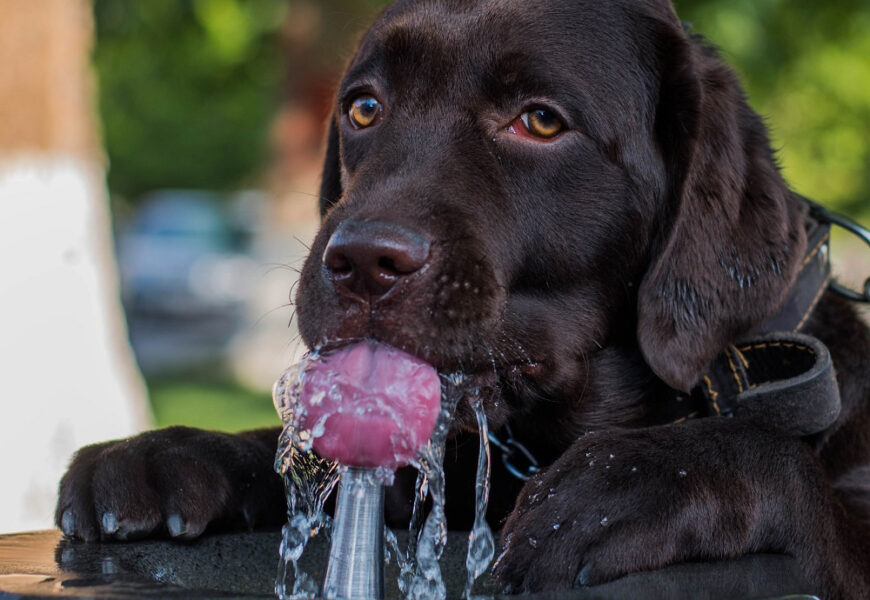Drinking water and your Lab.
Summer means sun and fun but also that special considerations need to be made for your Labrador to stay healthy and hydrated in the heat. Water is essential to keeping your Lab in good physical shape during hotter weather, and not just for playing either!
How much water should your Lab drink on a summer day while hanging out?
As a basic rule, your Lab should drink approximately 1 ounce of water (1/8 of a cup) per 1 pound of body weight each day. For a 65-pound Lab, that’s 65 ounces, or just over 8 cups of water. For an 80-pound Lab, that means 80 ounces or 10 cups of water. For a 100-pound Lab, it’s 100 ounces or 12.5 cups of water – every day. Water bowl sizes vary, but for a large-breed dog like a Labrador retriever, you’re probably going to have a Large or Extra-Large bowl, which typically holds between six to 12 cups of water at a time. Count on filling up an indoor water bowl at least twice a day to keep your Lab hydrated at the basic level.
How much water should your Lab drink on a summer day while active?
If you like to go walking, running, hiking, biking, or even swimming with your Lab, you’ll need to make sure he stays hydrated during and after such activities (just like you). Make sure your Lab is getting more frequent water breaks, every 15 to 20 minutes, during exercise, as well as a lengthy drink post-exercise. Your Lab doesn’t necessarily need to drink more ounces appropriate for his body weight, but don’t be surprised if he does on hot, active days.
What if your Lab is drinking a lot of water?
If your dog is drinking much more than what you’d expect – whether you’re basing this on his or her body weight or you know that it’s been a particularly hot or active day – then you need to take your Lab to the vet. There could be a medical condition such as kidney disease, diabetes, Cushing’s disease, Addison’s disease, UTI, or even behavioral issues. Your vet can run the necessary tests and help discover the appropriate prognosis.
What lurks in that stagnant water outside your Lab wants to drink?
Small lakes, ponds, and even standing water (such as outdoor water bowls) can spell trouble for your Lab. Common parasites your Lab could encounter from standing water include Giardia and Cryptosporidium, which cause diarrhea and vomiting. Leptospirosis is a type of bacteria that can be found in fresh water sources and is spread through the urine of infected animals. Leptospirosis causes kidney and liver disease; signs include diarrhea, refusing to eat, vomiting, stiffness, and lethargy. See a veterinarian immediately for any concerning symptoms.
Are you and your Lab on the go?
You can ensure your Lab has safe, clean drinking water everywhere you go this summer. Some favorite portable water bowls and bottles that are frequently used by hikers and campers include Prima Pets collapsible silicone travel bowl; Mud River Oasis’s rugged outdoor bowl that can hold 62 ounces of water; the Valterra Water-Hole Pet Dish or Kurgo’s No-Spill Dog Travel Bowl that don’t allow spills and splashes (great for messy Labs); and Ruffwear’s Packable Dog Bowl (large can hold more than 10 cups of water at a time). Outward Hound and Yeti also make travel dog bowls. When picking a portable water bowl, you’ll need to decide on material (typically plastic or silicone or waterproof canvas), whether you want something that collapses or not (depends on your chosen activities), and whether it’s manageable to clean and transport (some come with attached loops or carabiners). What kind of drinker is your Lab? Is he a bowl flipper? A slobberer? A splasher? Take your Lab’s “style” into consideration when evaluating water bowls and look for one that will help him keep more water in the bowl – and less in the surrounding area. Additionally, Kong, Kurgo, Highwave, and MalsiPree make some great canine-friendly designed water bottles, but your regular lineup of water bottles at local pet stores and sporting goods stores can work just as well. Just make sure you have a separate water bottle for yourself
Do additives help pull double duty in keeping your Lab healthy?
There are additives on the market that you can incorporate into your Lab’s water to help ensure a healthy and clean mouth. A water additive is only part of your Lab’s dental hygiene, and it can be an effective addition. Vets Preferred Advanced Oral Care Water Additive is marketed to freshen breath, remove plaque and tartar, and prevent gum disease. Oxyfresh’s Water Additive is made in the USA and has more than 28,000 positive reviews on Amazon. TropiClean uses green tea, and PetLab Co’s Dental Formula is touted to contain antimicrobial and antibacterial ingredients that target plaque and tartar buildup, giving you the ability to clean your Lab’s mouth in places a toothbrush can’t reach. There are several others available, so make sure you research prior to purchasing, including talking to your vet. Remember, bad breath can mean more than your standard periodontal disease; it can mean your Lab is on a poor diet, or your Lab may have a medical condition such as kidney disease, liver disease, or diabetes.
How does a dog actually drink?
We know that our canine friends drink water differently than us. We’re not just talking about the fact that they drink down into a bowl, we’re talking about the mechanics of getting that satisfying water in their mouths. Did you now that a dog’s tongue actually curls backward to bring water up? This lapping motion occurs quickly so as to build up momentum and pressure, forcing the water up into their mouths. And the deeper they splash their tongues, the more water they get. In fact, a dog’s tongue can exit its mouth up to 4 mph, which is a decent walking speed for us humans.




